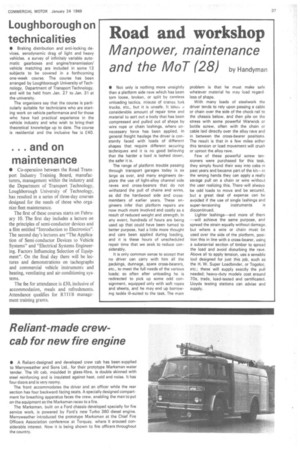Road and workshop
Page 39

If you've noticed an error in this article please click here to report it so we can fix it.
Manpower, maintenance
and the MoT (28) by Handyman • Not only is nothing more unsightly than a platform side rave which has been torn loose, broken, or split by careless unloading tactics, misuse of cranes, fork trucks, etc., but it is unsafe. It takes a considerable amount of repair time and material to sort out a body that has been compressed and pulled out of shape by wire rope or chain lashings, where unnecessary force has been applied. In general freight haulage the driver is constantly faced with loads of different shapes that require different securing techniques and it is no good believing that the harder a load is lashed dawn, the safer it is.
The range of platform trouble passing through transport garages today is as large as ever, and many engineers deplore the use of light-alloy channel side raves and cross-bearers that do not withstand the pull of chains and wires, as did the hardwood side and crossmembers of earlier years_ These engineers infer that platform repairs are now much more involved and costly as a result of reduced weight and strength. In any event, hundreds of hours are bemg used up that could have been turned to better purpose, had a little more thought and care been applied during loading, and it is these hours of unscheduled repair time that we seek to reduce considerably.
It is only common sense to accept that no driver can carry with him all the packings, dunnage, spare cross-bearers, etc., to meet the full needs of the various loads; so often after unloading he is redirected to pick up some odd consignment, equipped only with soft ropes and sheets, and he may end up borrowing tackle ill-suited to the task. The main
problem is that he must make safe whatever material he may load regardless of shape, With many loads of steelwork the driver tends to rely upon passing a cable or chain over the side of the chock rail to the chassis below, and then pile on the stress with some powerful Warwick or bottle screw, often with the chain or cable laid directly over the alloy rave and in between the cross-bearer positions. The result is that in a few miles either this tension or load movement will crush ar uproot the alloy rave.
Few of these powerful screw ten-. sioners were purchased for this task, they simply found their way into cabs in
past years and became part of the kit In the wrong hands they can apply a really savage pull on a chain or wire without the user realizing this. There will always be odd loads to move and be secured, but a great deal of expense can be avoided if the use of single lashings and
super-tensioning instruments is discontinued.
Lighter lashings—and more of them —will achieve the same purpose, and spread the strain equally without damage, but where a wire or chain must be used over the side of the platform, position this in line with a cross-bearer, using a substantial section of timber to spread the load and avoid disturbing the rave. Above all to apply tension, use a sensible tool designed for just this job, such as the FL W. Super Loadbinder, or Togoloc, etc.; these will supply exactly the pull needed: heavy-duty models cost around 70s, trade, load-tested and certificated. Lloyds testing stations can advise and supply.








































































































